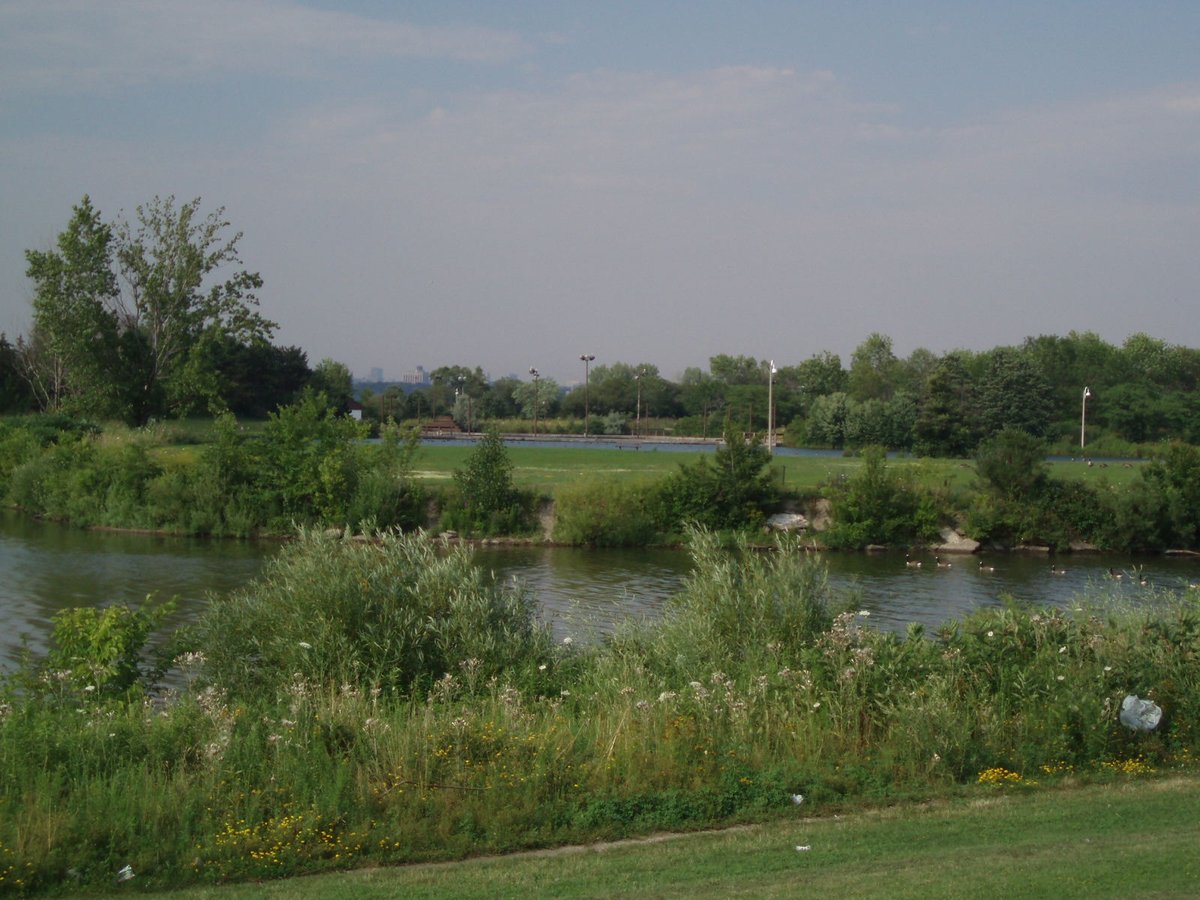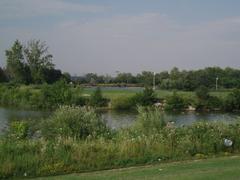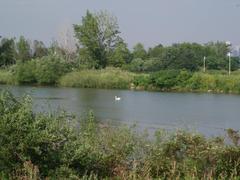
Humber Bay Park Visiting Hours, Tickets, and Travel Guide – Toronto Historical Sites
Date: 15/06/2025
Discover Humber Bay Park: Essential Visitor Information, History, and Travel Tips
Nestled on the tranquil shores of Lake Ontario in Toronto’s west end, Humber Bay Park is a celebrated urban sanctuary that seamlessly blends natural beauty, cultural heritage, and recreational offerings. Established in 1984 atop two reclaimed peninsulas—Humber Bay Park East and West—the park has become a beloved destination for both locals and visitors. Here, you’ll encounter panoramic skyline views, flourishing wildlife habitats, and a landscape restored to support native flora and fauna. The park’s historical tapestry weaves together Indigenous roots, early European exploration, and Toronto’s evolving waterfront.
This detailed guide covers everything you need to plan your visit: opening hours, ticket and parking details, accessibility, historical and ecological highlights, amenities, and travel tips. For more in-depth information on ongoing projects, amenities, and events, consult the City of Toronto and Toronto and Region Conservation Authority (TRCA) resources.
Table of Contents
- About Humber Bay Park
- Historical Overview
- Park Layout and Features
- Visiting Hours and Admission
- Getting There
- Accessibility
- Facilities and Amenities
- Recreational Activities
- Ecological Importance
- Cultural Significance
- Special Events and Community Activities
- Top Photography Spots
- Nearby Attractions
- Travel Tips and Safety
- Ongoing Improvements and Conservation
- Frequently Asked Questions (FAQs)
- Plan Your Visit & Stay Connected
- Sources
About Humber Bay Park
Located at the mouth of Mimico Creek, Humber Bay Park spans over 43 hectares of reclaimed land, divided into East and West peninsulas. It features lush green spaces, diverse wildlife habitats, multi-use trails, picnic areas, and unique recreational facilities, all set against the dramatic backdrop of Toronto’s skyline.
Historical Overview
Indigenous Heritage and Early Settlement
The Humber Bay region has a rich Indigenous legacy. The Mississaugas called it “wah-do-be-kang” (wadoopikaang), meaning “place where the black/wild alders grow,” a name that evolved into “Etobicoke.” The area also held significance as “Omimeca,” or “resting place of the wild pigeons.” For centuries, the Humber River and its marshes were vital travel and trade routes for First Nations.
French explorer Étienne Brûlé was likely the first European to visit in 1615, marking the beginning of European exploration and settlement.
Community Growth and Urbanization
By the late 1800s, Humber Bay was a rural community supplying Toronto with fresh produce. The first schoolhouse, built in 1888, became a community hub. The area also hosted Toronto’s inaugural farmers’ market, now home to the Ontario Food Terminal.
In the mid-20th century, the lakeshore transformed into the “motel strip,” a bustling route for travelers. Urban redevelopment eventually replaced these motels and farms with residential towers and commercial spaces.
Creation and Restoration of Humber Bay Park
Humber Bay Park opened in 1984, constructed with over 5 million cubic metres of lakefill. The park’s design prioritized green space, wildlife habitat restoration, and public recreation. Over time, naturalization projects have enhanced habitats for birds, butterflies, and native plants, making the park a vital ecological refuge.
Ongoing Renewal
Rapid urban growth in the Humber Bay Shores area has spurred revitalization projects, including improved parking, new wetlands, pedestrian bridges—like the iconic Humber Bay Arch Bridge—and enhanced farmers’ market spaces (City of Toronto).
Park Layout and Features
Humber Bay Park West
- Location: South of Lake Shore Boulevard West, west of Mimico Creek.
- Landscape: Six armourstone headlands and three rubble beaches protect the shoreline (TRCA).
- Amenities: Paved and gravel trails (part of the Martin Goodman Trail), fishing coves, wildflower meadows, and access for fishing, kayaking, and canoeing.
Humber Bay Park East
- Location: East of Mimico Creek.
- Landscape: Features open lawns, constructed wetlands, butterfly gardens, and elevated lookouts with city and lake views.
- Restoration: Wetlands support aquatic and terrestrial wildlife; gardens and pollinator plantings attract Monarch butterflies and other species.
Visiting Hours and Admission
- Hours: Open daily, year-round, from dawn to dusk. Summer hours may extend to 11:00 PM in some sections (Tour by Transit).
- Admission: Free entry; no tickets required.
- Parking: Paid parking lots are available near both East and West entrances; some street parking is also available.
Getting There
- By Car: Use Lake Shore Boulevard West and follow signs for Humber Bay Park East or West.
- Public Transit: TTC buses 501 Queen and 110 Islington South serve the area.
- Cycling: The Martin Goodman Trail connects the park with other waterfront destinations (Great Runs).
Accessibility
The park features paved, accessible pathways, wheelchair-friendly washrooms, designated parking, and accessible picnic areas. Many viewpoints and facilities are designed to accommodate visitors with mobility challenges.
Facilities and Amenities
- Multi-Use Trails: Linked to the Martin Goodman and Waterfront Trail systems.
- Picnic Areas: Tables and shelters in both East and West sections.
- Boat Launch: Public launch in Humber Bay Park West.
- Yacht Clubs: Located within the park.
- Dog Off-Leash Area: Large fenced dog park in the West section.
- Fishing: Accessible fishing pier and designated fishing spots.
- Washrooms: Accessible facilities, open seasonally.
- Wayfinding: Trail maps and clear signage throughout the park.
Recreational Activities
Visitors can enjoy:
- Walking, jogging, and cycling on extensive trails
- Birdwatching and wildlife observation (over 100 bird species recorded annually)
- Butterfly watching in dedicated pollinator gardens
- Fishing, kayaking, and canoeing
- Picnicking with friends and family
- Photography, especially sunrise/sunset and skyline views
Ecological Importance
Biodiversity and Habitat
Humber Bay Park’s wetlands, meadows, and woodlands support a remarkable diversity of wildlife:
- Birdlife: The park is a hotspot for birdwatching, especially during migration (eBird). Over 161 native bird species have been recorded, including many of regional conservation concern (TRCA).
- Butterflies and Pollinators: The Humber Bay Butterfly Habitat is a major draw for Monarchs and other native species (City of Toronto).
- Wetlands: Constructed wetlands filter stormwater and provide habitat for amphibians, reptiles, and aquatic invertebrates.
- Native Plant Communities: Ongoing restoration supports native trees, wildflowers, and grasses, enhancing the park’s ecological integrity.
Conservation and Stewardship
- Community Stewardship Program: Volunteers help with habitat restoration, invasive species removal, and ecological monitoring (City of Toronto).
- Scientific Monitoring: The TRCA conducts annual assessments of birds, frogs, plants, and vegetation communities, guiding adaptive management and restoration (TRCA).
Cultural Significance
- Indigenous and Historical Context: The park sits at a historically significant site for First Nations and early European traders, with legacy trails and interpretive signage (ToDoCanada).
- Community Engagement: Seasonal events like the Remembrance Race and Lakeshore Mardi Gras foster a sense of connection and celebration.
- Educational Features: The butterfly habitat, interpretive signs, and stewardship programs provide valuable learning opportunities.
Special Events and Community Activities
- Humber Bay Shores Farmers’ Market: May to October, featuring local produce and artisanal goods (Torontoforyou).
- Guided Nature Walks: Led by local organizations and naturalists.
- Fitness and Yoga Classes: Outdoor classes in warmer months.
- Community Festivals: Including cultural celebrations and ecological awareness events.
Top Photography Spots
- Humber Bay Arch Bridge: Offers iconic views of the Toronto skyline.
- Eastern Shoreline: Best for sunrise photography.
- Western Peninsula: Unmatched sunset and cityscape perspectives.
- Wildlife Areas: Butterfly gardens and wetlands for close-up nature shots.
Nearby Attractions
- Ontario Food Terminal Market
- Mimico Waterfront Park
- Humber Bay Shores Park
- South Humber Park (access to Toronto’s ravine system)
- Downtown Toronto (via cycling or transit)
Travel Tips and Safety
- Visit early or late in the day for tranquility and best lighting.
- Dress in layers and bring sun protection; Lake Ontario’s shore can be breezy.
- Pack water and insect repellent during summer visits.
- Stay on marked trails to protect wildlife and habitats.
- Check City of Toronto for real-time updates on construction or closures.
Ongoing Improvements and Conservation
The Humber Bay Park Master Plan guides revitalization through 2025, including:
- Wetland and habitat restoration
- New boardwalks, bridges, and accessible paths
- Infrastructure upgrades for sustainability and safety
- Shoreline maintenance to protect against erosion (TRCA)
Frequently Asked Questions (FAQs)
Q: What are Humber Bay Park’s hours?
A: Open daily from dawn to dusk; some areas may have extended summer hours.
Q: Is there an entrance fee?
A: No, the park is free to enter.
Q: Are dogs allowed?
A: Yes, with on-leash rules and a designated off-leash area in the West section.
Q: Is the park accessible for people with mobility challenges?
A: Yes, paved trails, accessible washrooms, and parking are available.
Q: Where can I park?
A: Paid parking lots are located at both entrances, with accessible spaces.
Q: Can I fish or launch a boat?
A: Yes, there are designated fishing areas and a public boat launch in Humber Bay Park West.
Plan Your Visit & Stay Connected
Humber Bay Park is a must-visit Toronto destination for nature lovers, history enthusiasts, and families. Its blend of ecological richness, historical depth, and urban recreation makes it a unique spot on the city’s waterfront. For updates on events, trail conditions, and revitalization, visit the official City of Toronto website and TRCA.
Download the Audiala app for guided tours, event updates, and insider tips—and follow us on social media for more Toronto park highlights.
Sources
- City of Toronto – Humber Bay Parks Master Plan
- TRCA – Humber Bay Park West Major Maintenance
- TRCA – Biological Inventories and Assessments
- Tour by Transit – Humber Bay Park
- Torontoforyou – Humber Bay Park
- eBird – Humber Bay Park East Hotspot
- DTAH – Humber Bay Park Master Plan
- ToDoCanada – Things to Do in Etobicoke




























































































































































































